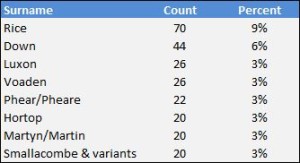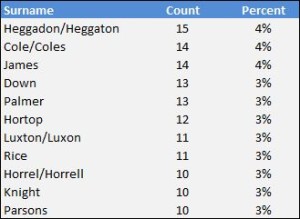Bratton Clovelly Surnames, 1641-2000
The purpose of this study is to identify the most frequent surnames in Bratton Clovelly through the centuries. The following sources have been used:
- Bratton Clovelly Protestation Returns 1641, sample size 129
- Bratton Clovelly Hearth Tax 1674, includes exempt paupers, sample size 79
- Bratton Clovelly Marriages 1754-1800, brides and grooms from the parish, sample size 307
- Bratton Clovelly Baptisms 1813-1850, sample size 771
- Bratton Clovelly Baptisms 1851-1900, sample size 376
- Bratton Clovelly Baptisms 1901-1950, sample size 232
- Bratton Clovelly Baptisms 1951-2000, sample size 174
These sources were chosen based on what is currently transcribed and what can represent surnames of the total Bratton Clovelly population through time, rather than specific groups such as landowners. However, the sources have significant limitations and can only provide indicative statistics:
- Sample sizes vary greatly so raw counts are not comparable. Percentage of sample is the more useful statistic.
- Sample sizes in the 1600s are limited and reflect heads of household rather than entire families.
- Marriages in the 1700s again do not reflect family size nor those who didn’t marry. They also don’t reflect those who married in denominations other than the parish church. However, Rev Thomas Skynner reported in the Episcopal Visitation Return of 1779 that ‘We have not any reputed Papists, nor dissenting Congregations.’
- Baptisms 1813-2000 only reflect those baptised in the parish church. The Civil Registration would be preferable but Bratton Clovelly births are registered as part of the Okehampton District so are not readily segregated. There were Bible Christian and Methodist chapels in the parish from the 1800s whose family names may be under-represented. In addition, especially for more recent baptisms, there may be children who were not baptised.
Accepting the limitations of the data, these sources still offer a remarkably detailed glimpse of the families who lived in Bratton Clovelly through 400 years. When the medieval Manor Rolls have completed translation, this window will be able to cover 700 years of the parish’s history.
The charts below show the surnames that accounted for at least 3% of the given sample. They show that Bratton Clovelly remained a diverse community, with the large majority of the parish holding surnames that occurred infrequently. The surname Pengelly in the 1641 sample and Rice and Down in the 1813-1850 sample stand out as representing a substantial portion of the sample but neither of these names occur at unusually high frequency in the other samples. The last sample of 1951-2000 reflects a highly diverse community in terms of surnames, with only three surnames representing 3% of the population each and all remaining names representing 1% or less.
There is also significant change in the most frequent names throughout the centuries, reflecting a dynamic community. In this analysis, the most enduring surname appears to be Voaden, seen as Vawden in the 1641 sample and only absent from the 1674 and 1901-1950 samples but re-emerging in the 1951-2000 sample.






